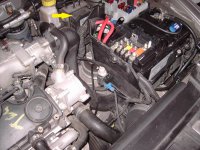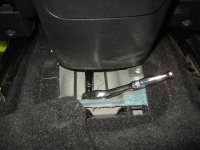Mytheroo
New member
hi all, My 1.6 3-door failed on handbrake efficiency, but was probably so low that balance couldn't actually be tested. It passed on rear footbrake.
I've replaced pads and disks, bled, done the correct re-install procedure a few times. Bedded in (they are EBC disks and pads so have the bedding in material on. Footbrake applies well, can't turn with breaker bar on wheel nut kind of thing, and balance between rears seems similar at a foot pedal pressure where wheels can be turned with breaker bar on wheel nut.
I've removed the rubber bits on the top caliper sliders. NSR is a bit stickier than OSR with regards to pads releasing on pedal release, but it rolls fine, and starts rolling on minimal slope etc, nothing I'd think of as binding.
Handbrake starts activating before first notch, but overall efficency is just low, I can't lock the rears even in the wet. Stopping from say 10mph with handbrake only takes e.g. 3-5 seconds.
I don't really know what goes on inside the caliper when the handbrake is applied, some kind of rotating cam that reduces the volume inside? And a ratchet kind of thing for the auto-adjuster?
When I activate the handbrake level on the caliper with a lever (screwdriver) both sides rotate about the same amount before jamming solid and locking the hub, but I don't know (yet) if using the in-car handbrake lever moves them the same amount.
The in-car handbrake lever is moderately stiff, but tightens to a point on last notch where I'm about at my limit of strength applying it. And at this point the efficiency still feels low (and doesn't lock the wheels etc)
My unknown is not really knowing what can go wrong internally in the caliper. I guess it might just be stretchy cables though?
Any help appreciated
I've replaced pads and disks, bled, done the correct re-install procedure a few times. Bedded in (they are EBC disks and pads so have the bedding in material on. Footbrake applies well, can't turn with breaker bar on wheel nut kind of thing, and balance between rears seems similar at a foot pedal pressure where wheels can be turned with breaker bar on wheel nut.
I've removed the rubber bits on the top caliper sliders. NSR is a bit stickier than OSR with regards to pads releasing on pedal release, but it rolls fine, and starts rolling on minimal slope etc, nothing I'd think of as binding.
Handbrake starts activating before first notch, but overall efficency is just low, I can't lock the rears even in the wet. Stopping from say 10mph with handbrake only takes e.g. 3-5 seconds.
I don't really know what goes on inside the caliper when the handbrake is applied, some kind of rotating cam that reduces the volume inside? And a ratchet kind of thing for the auto-adjuster?
When I activate the handbrake level on the caliper with a lever (screwdriver) both sides rotate about the same amount before jamming solid and locking the hub, but I don't know (yet) if using the in-car handbrake lever moves them the same amount.
The in-car handbrake lever is moderately stiff, but tightens to a point on last notch where I'm about at my limit of strength applying it. And at this point the efficiency still feels low (and doesn't lock the wheels etc)
My unknown is not really knowing what can go wrong internally in the caliper. I guess it might just be stretchy cables though?
Any help appreciated



